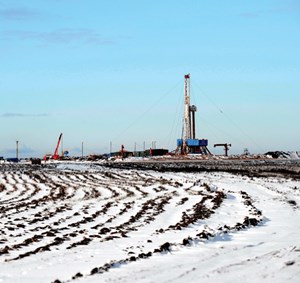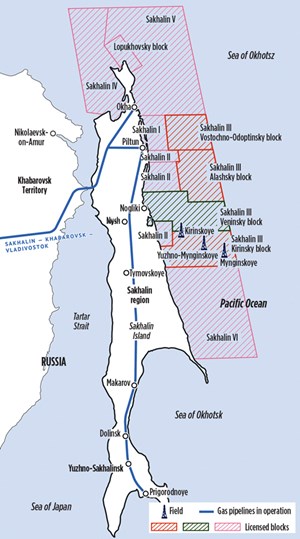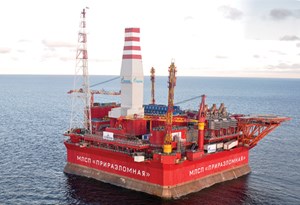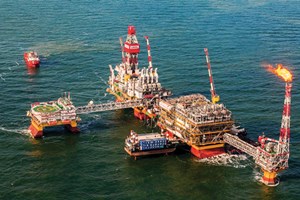Able to boost production considerably, Russia’s commitment to international efforts that limit output has yet to be confirmed
By surface area, Russia is the world’s largest country, and it also contains the globe’s largest natural gas reserves. Because it is recognized as an energy superpower, Russia retains significant leverage with regard to global energy output. Although it is not a member of OPEC, Russia has been an integral part of the group’s efforts to cut production and curtail global stockpiles. In May, the country agreed to join OPEC in extending those production cuts through first-quarter 2018.
Following an OPEC and non-OPEC ministerial meeting on May 25 in Vienna, Russia was among those nations agreeing that production adjustments were necessary for an additional nine-month period, beginning July 1, 2017. According to OPEC, participating non-OPEC producers had “recognized the need for continuing cooperation among oil exporting countries, in order to achieve a lasting stability in the oil market.”
Some analysts have reservations, however, about the country’s ability to follow through on the cuts, particularly after the agreement officially ends in 2018. These concerns stem primarily from the hefty amount of investment that the country has poured into many of its newly discovered oil fields. “Rosneft, the state-owned champion, will have invested a lot of money in these fields that will be sitting idle, if they continue to extend the agreement,’’ Ronald Smith, senior oil analyst at Citigroup Inc. in Moscow, told Bloomberg. “The math is going to be more ambiguous going forward. At some point, they may decide they need to take back some market share.’’
Last year, Russia achieved post-Soviet records, despite low commodity prices and an economic recession. Goldman Sachs analysts have said that Russian output is on track to exceed the Soviet record of 11.42 MMbopd, which was set in 1987. Analysts have predicted that the country’s output will rise 590,000 bopd, to 11.65 MMbopd, by 2018.
Projections by the International Energy Agency (IEA), however, oppose those of Goldman analysts. In July 2016, the agency estimated that Russian production would, in fact, decline in 2018, to 10.94 MMbopd.
According to Rosneft, Russia’s largest oil company, the country can add as much as 4 MMbopd. It has been said that the company aspires to become a major international player, much like Exxon Mobil or Shell; however, an economic recession and recent sanctions have thwarted that plan.
Given its capacity to boost production considerably, in addition to rising Chinese and European demand, Russia’s commitment to international efforts limiting output remains to be seen.
WESTERN SIBERIA
Last year, Gazprom Neft reported that Novoportovskoye field’s millionth tonne of oil had been produced. The gas-condensate field—found in the Yamalo-Nenets Autonomous District of Western Siberia—has been developed slowly, due to its remote location, about 155 mi north of Nadym and nearly 19 mi from the Gulf of Ob shoreline. Although it was first discovered in 1964, development did not begin until 2012.
However, in April, Gazprom Neft reported that it had completed drilling of its first production well within the NP-8 stratum at Novoportovskoye field. The stratum reportedly is expected to deliver about 25% of all oil produced at the field over the next three years. By the end of the year, Gazprom Neft expects to drill 14 more wells at Novoportovskoye’s NP-8 stratum. The company reportedly plans to drill 50 wells by 2019.
More progress was made in Western Siberia last year, when Lukoil started commercial oil production at Pyakyakhinskoye field. The company reported that 72 oil wells and 31 gas wells had been drilled at the field, which is situated in the Yamal-Nenets Autonomous District, as well. Of the oil wells, 36 reportedly were producing, with a daily flowrate exceeding 20,000 bopd. The field is one of the largest in the district, in terms of hydrocarbon reserves discovered and put into commercial production over the last few years. Recoverable reserves are estimated at 630.4 MMbbl of oil and gas condensate, and 9.2 Tcf of gas.

In January 2017, gas production at the field started. By early March, Lukoil reported that accumulated natural gas production had exceeded 14.13 Bcf. The gas wells’ average daily flowrate reportedly exceeded 10.6 MMcfd.
Also in January, Gazprom Neft struck oil in the Sorochinsky District of Orenburg Oblast, Fig. 1. Novosamarskoye field is reportedly the first discovery in the area, which is believed to hold a series of smaller deposits. Reservoir engineers estimated the new field’s oil-in-place reserves at more than 58.6 MMbbl. “The discovery of the Novosamarskoye field confirms our view regarding the presence of several fields at the Uransky license block. Increasing precision in geological prospecting, together with enhanced oil recovery rates, mean Gazprom Neft is able to bring smaller reserves into development on a viable basis. We plan to drill two more exploratory wells at the Novosamarskoye oil field as part of production testing [in 2017],” said Vadim Shashel, head of geological prospecting at Gazprom Neft.
Moreover, Gazprom Neft acquired development rights for two new assets in the Yamalo-Nenets Autonomous Okrug—Tazovskoye and Severo-Samburgskoye fields. Tazovskoye, which sits more than 310 mi northeast of Salekhard, is said to contain 527.8 MMbbl of recoverable oil reserves and 37.6 MMbbl of condensate. Additionally, it is believed to hold 6.5 Tcf of free gas. The Severo-Samburgksoye license block is situated in the Purovsky District, about 62 mi north of Novy Urengoy. It is believed to hold more than 660 MMbbl of recoverable oil reserves. According to Gazprom Neft, pre-commissioning work is already underway at the field. Pilot drilling is scheduled to take place this winter.
“Gazprom Neft is continuing its ongoing development of what is a key region for the company—the Yamalo-Nenets Autonomous Okrug. It was here that we commissioned two of the most significant fields—Novoportovskoye and Vostochno-Messoyakhskoye—in 2016. Concurrently, Gazprom Neft is, thanks to the implementation of cutting-edge technologies, continuing to increase production at traditional fields in the Noyabrsk region,” said Vadim Yakovlev, first deputy CEO at Gazprom Neft.
One example of these technologies is Gazprom Neft’s program directed at further developing technologies that will aid in the exploitation of oil reserves found below a gas cap. Implementation of these technologies is expected to allow some 1.6 Bbbl of oil reserves to be extracted. According to Gazprom Neft, the program has been established by employees of Gazprom Neft Joint Scientific and Research Center, and includes 13 technological initiatives that are directed at understanding downhole surveys, anticipating the gas input factor and developing valuable engineering tools, equipment and algorithms for the effective operation of wells with substantial gas content.
Rosneft made a discovery in Western Siberia early this year, as well. In March, the company announced the discovery of Anastasyinskoye field in the Republic of Bashkortostan, situated between the Volga River and the Ural Mountains. The field was discovered, following the drilling of two exploration wells in the West Kungak license area. The drilling success reportedly has given Rosneft reason to believe that more fields will be discovered in Bashkiria this year.
Rosneft furthered its E&P efforts in Western Siberia this year, after it acquired a 100% stake in the Kondaneft project, in the Khanty-Mansiysk Autonomous District. The project is developing the Kondinsky, Zapadno-Erginsky, Chaprovsky and Novo-Endyrsky license areas. This set of fields is found approximately 62 mi from Priobskoye field, which is one of Rosneft’s key assets. With infrastructure already in place, the project is expected to begin producing this year. It likely will be one of the country’s chief production areas.

EASTERN SIBERIA/FAR EAST
The Sea of Okhotsk, found in Russia’s Far East, has been an exploration hot spot of late. In addition to prominent explorers, like Rosneft and Statoil, Gazprom has focused much of its E&P activity in the offshore area. It is engaged in the exploration of three licensed blocks—Kirinsky, Ayashsky and Vostochno-Odoptinsky—as part of the Sakhalin III project, Fig. 2. The Kirinsky block is home to the Kirinskoye gas and condensate field, in addition to the Yuzhno-Kirinskoye and Mynginskoye gas and condensate fields.
In September, Gazprom reported the discovery of a new gas and condensate field near Sakhalin Island, within the Kirinsky block. The discovery was made while drilling a prospecting and appraisal well in the Yuzhno-Lunskaya structure. The company reported imminent plans to begin testing of the gas and condensate inflow.
Gazpromneft-Sakhalin, a subsidiary of Gazprom Neft, announced plans in February to drill the first prospecting and appraisal well in the Ayashsky offshore license block. A contract with Hakurya 5, Inc., a subsidiary of Japan Drilling Co., was signed for a semisubmersible rig. The rig reportedly will begin drilling this summer. Additionally, it will conduct well testing and core sampling. This represents the first time that any exploratory or appraisal drilling has taken place in the Ayashsky block.
Lukoil, too, has increased E&P activity throughout eastern Siberia and the Far East. In early April, the company announced that it had begun exploration drilling in the Vostochno-Taymyrsky license area, in the Krasnoyarsk Territory of eastern Siberia. According to Lukoil, no other exploration companies have drilled a deep well into the region’s Lower Cambrian strata.
Lukoil President and CEO Vagit Alekperov explained, “In 2013, I reported to Russia’s President Vladimir Putin that Lukoil was ready to develop the Vostochno-Taymyrsky area, despite zero infrastructure, harsh climate and high costs. We completed a great deal of preliminary operations, and once again proved our high competence and ability to meet challenges, as we started drilling the first exploratory well in the Vostochno-Taymyrsky license area six months ahead of schedule. We focus on replenishing Russia’s resource base and developing it in the most effective way.”
By the end of the month, the company had drilled the first 3,280 ft of the 1P exploration well. Lukoil said that more than 1,227 ft of core samples from eight formations were being recovered and analyzed.
ARCTIC
Due to the harsh environment, there are only a few operators willing to invest in the exploration of Russia’s Arctic. However, Gazpromneft Shelf, a subsidiary of Gazprom Neft, commissioned two new production wells at Prirazlomnoye field in August 2016—bringing the field’s total number of production wells to four.

Prirazlomnoye is found more than 37 mi off Russia’s northern coast, in the Pechora Sea. Presently, it is the only Russian hydrocarbon production project on the entire Arctic shelf. With the two additional wells, the field’s ice-resistent platform—which serves as the main pre-development facility—has reached a daily production figure of 6,000 tonnes, or nearly 44,000 bopd, although this number seems high, Fig. 3. In late January, the company reported that it had added two more production wells—bringing the field’s aggregate number of production wells to six. Gazprom Neft reportedly intends to eventually commission a total of 32 wells at Prirazlomnoye. This development plan is expected to streamline production of the field’s estimated 513 MMbbl of oil.
Gazprom Neft reported in January that it had met all annual production targets at the Prirazlomnaya platform, with a total 15.79 MMbbl of Arctic oil being produced at the field during 2016. This represented more than double the volumes produced the year prior.
In April, a significant technological advancement took place at the Arctic platform. It was announced that the first-ever, multi-hole “fishbone” well had been drilled and commissioned at Prirazlomnaya. The well, which is the platform’s fourth injection well, involves multiple horizontal branches. The fishbone trajectory purportedly does not require separate well construction for each horizontal shaft, consequently reducing drilling costs and the extent of work required. According to Gazprom Neft, each horizontal section targets a specific oil-bearing section of the strata, increasing the well’s injection capacity, as well as the total drainage area.
“As a result of the seamless work of the Gazprom Neft Shelf team, the additional horizontal shafts were drilled all in one go, five days ahead of schedule. The most cutting-edge technologies—which are both effective and safe—have been used in developing what is a unique project on the Russian Arctic shelf,” said Andrey Patrushev, deputy CEO for offshore development at Gazprom Neft.

CASPIAN SEA
The northwestern segment of the Caspian Sea is home to Russia’s largest discovery in more than 25 years. Discovered in 2005, Vladimir Filanovsky field is situated about 118 mi off Astrakhan and is the second field to be launched by Lukoil. With an estimated 290 MMbbl of proven reserves (as of late 2015) and 1.1 Tcf of gas, it was announced in late October that the field had begun commercial production.
The following month, a third well was completed at Vladimir Filanovsky field, Fig. 4. By March, Lukoil announced the completion of the field’s fourth well. After putting the well into operation, the company announced that a fifth well, also of dual lateral design, would be spudded. By the end of April, Lukoil reported that the field had produced its 2 millionth tonne (14.7 MMt) of oil.
Lukoil reported more progress at Vladimir Filanovsky field in April. As the company prepared to enter Phase 2 of the field’s development, transportation of the topsides of a fixed, offshore ice-resistant platform (LSP-2) commenced. The 7,000-tonne topsides were towed, using a tugboat caravan. According to Lukoil, the second phase of development includes construction of a fixed ice-resistant platform, an accommodation-topsides platform and a crossover between the platforms. Start-up of the facilities is expected by year-end. ![]()


